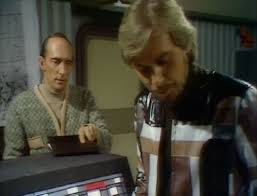
Two seismologists disappear while working in the Mare Frigoris area of the Moon. A search of the area turns up empty. Not knowing why the workers disappeared, Director Caulder (Donald Houston) bans all work in the area until an explanation is found. Professor Heinz Laubenthal (Peter Miles) is working on a sensitive project in the Mare Frigoris area and is upset that he is unable to continue with his research. He refuses to tell Caulder what he is researching until he has something more substantial to report.
Laubenthal disregards orders and returns to the Mare Frigoris to conduct an experiment. Sometime later Laubenthal is killed in an explosion in the seismology lab. When a team examines the damage it is determined that the lab was blown in and that Laubenthal had substantial damage to his body that couldn’t be contributed to exposure to space. Also, outside the lab walls is seen are large prints on the surface of the Moon that look like the tracks of something going away from the lab. Eventually Laubenthal’s assistant, Per Bengtson (Jurgen Andersen), confirms that his boss believed there may be life on the Moon.
Rumors begin to spread throughout Moonbase 3 that there is a monster on the Moon. Some of these rumors are spread by Dr. Peter Conway (John Hallam). The rumors begin to spread to the other Moonbases. Deputy Director Michel Lebrun (Ralph Bates) assigns Conway to assist Bengtson in going through Laubenthal’s papers to find out what the scientist was doing.
Caulder decides that he must investigate Mare Frigoris to put an end to the rumors. He takes two teams of men with him. In the meantime, solar flare activity is creating havoc with, not only the weather on Earth, but communication systems on the Moon as well.
Mare Frigoris is a long, thin lunar sea that stretches east to west along the northern part of the Moon. It is 1,400 kilometers in length. A lunar maria is a large, dark, basaltic plain on the Moon’s surface. They were formed by asteroid impacts. The name maria is Latin for 'seas'. These areas were named by early astronomers who mistook them for actual seas. They are in contrast to the bright lunar highlands and form the face of the “man in the moon.”

